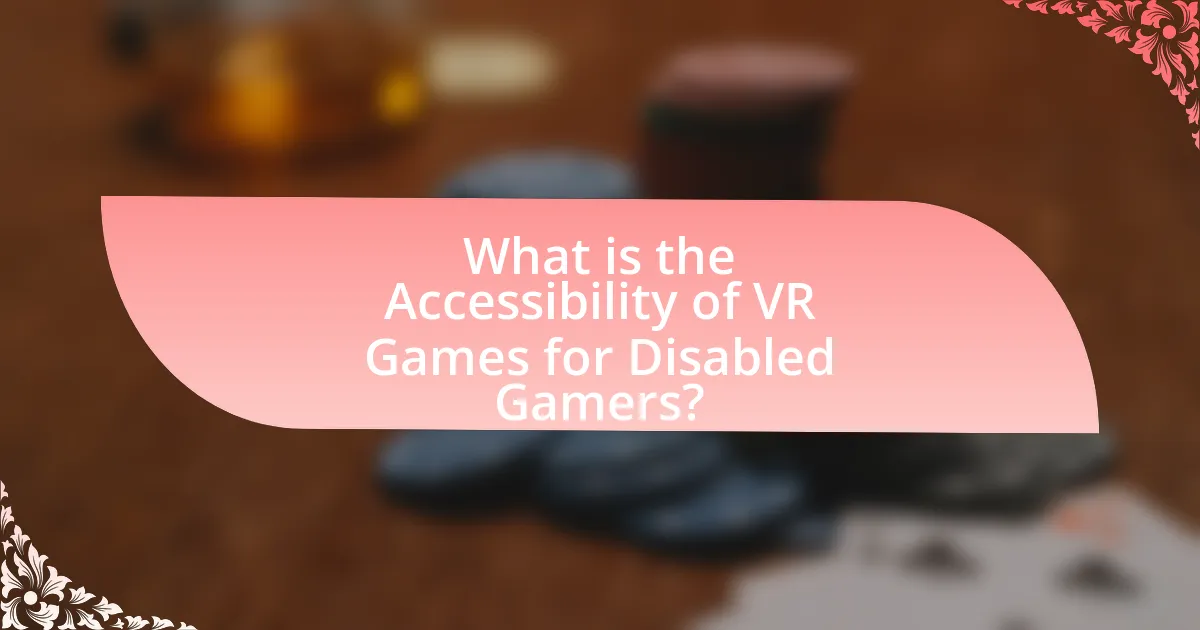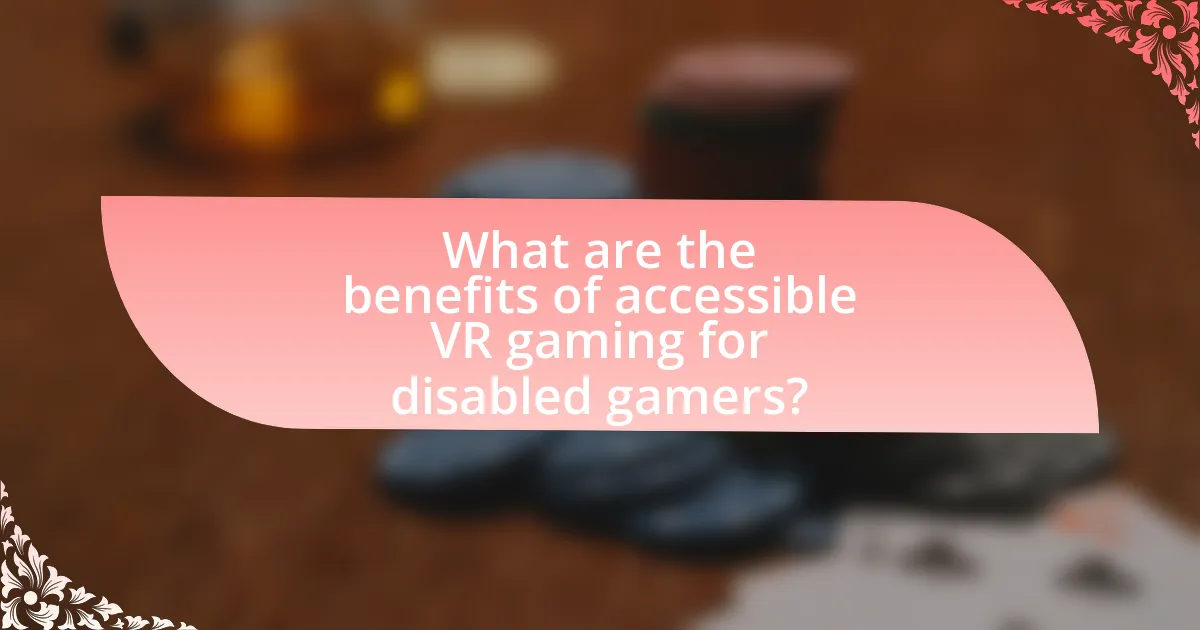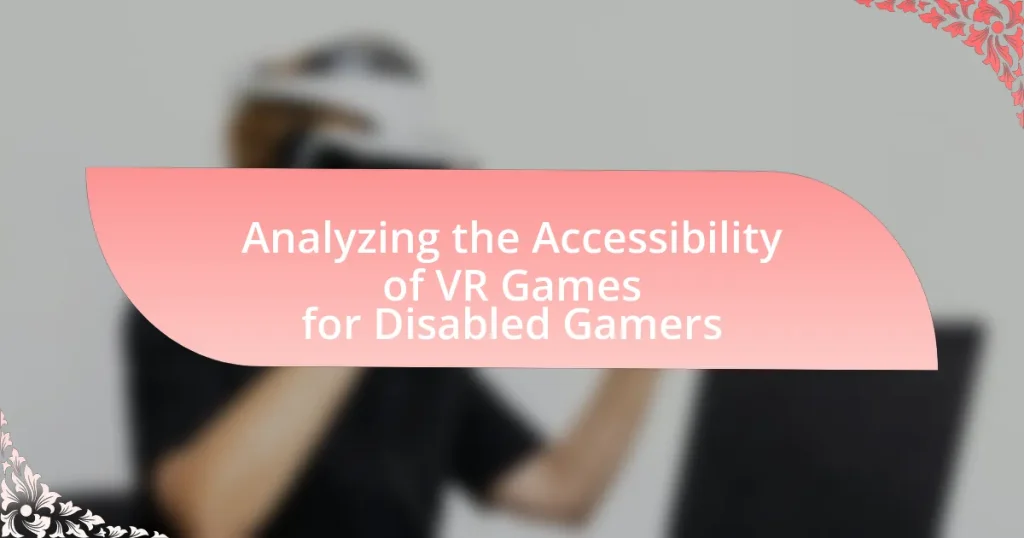The article analyzes the accessibility of virtual reality (VR) games for disabled gamers, highlighting the varying levels of inclusivity across different titles. It discusses the importance of accessibility features such as customizable controls, adjustable difficulty settings, and adaptive hardware, which enhance the gaming experience for individuals with disabilities. The article also addresses the challenges disabled gamers face in traditional gaming environments and the unique obstacles presented by VR technology. Furthermore, it outlines current accessibility standards, the role of organizations in setting guidelines, and the potential benefits of accessible VR gaming for both players and the gaming industry.

What is the Accessibility of VR Games for Disabled Gamers?
The accessibility of VR games for disabled gamers varies significantly, with some games incorporating features that enhance usability while others lack essential adaptations. Many VR developers are increasingly recognizing the importance of inclusivity, leading to the implementation of customizable controls, adjustable difficulty settings, and options for one-handed play. For instance, games like “Beat Saber” offer options for players with limited mobility, allowing them to play using one hand or with adaptive controllers. Additionally, research from the International Game Developers Association indicates that 70% of game developers are actively considering accessibility features in their designs. This growing awareness is crucial for ensuring that disabled gamers can enjoy immersive experiences in virtual reality.
Why is accessibility important in VR gaming?
Accessibility is important in VR gaming because it ensures that individuals with disabilities can fully participate in and enjoy the gaming experience. By incorporating features such as customizable controls, visual and auditory aids, and adaptable gameplay mechanics, developers can create inclusive environments that cater to diverse needs. Research indicates that approximately 15% of the global population lives with some form of disability, highlighting the necessity for accessible gaming options to reach a broader audience and promote equality in entertainment.
What challenges do disabled gamers face in traditional gaming environments?
Disabled gamers face significant challenges in traditional gaming environments, primarily due to a lack of accessibility features. Many games do not accommodate various disabilities, such as visual impairments, hearing loss, or mobility issues, which can hinder gameplay and enjoyment. For instance, a study by the International Game Developers Association found that 83% of game developers do not prioritize accessibility in their design processes, leading to barriers that prevent disabled individuals from fully engaging with games. Additionally, the physical design of gaming consoles and controllers often does not consider the needs of users with limited dexterity, further complicating their ability to participate in gaming.
How does VR technology present unique accessibility challenges?
VR technology presents unique accessibility challenges primarily due to its reliance on physical interaction and sensory immersion, which can be difficult for individuals with disabilities. For instance, users with mobility impairments may struggle with the physical movements required to navigate virtual environments, while those with visual impairments may find it challenging to engage with content that relies heavily on visual cues. Additionally, VR experiences often require the use of specialized hardware, such as headsets and controllers, which may not be designed with accessibility features, limiting usability for individuals with various disabilities. Research indicates that approximately 15% of the global population experiences some form of disability, highlighting the need for VR developers to prioritize inclusive design to ensure equitable access to virtual experiences.
What are the current standards for accessibility in VR games?
Current standards for accessibility in VR games include compliance with guidelines such as the Web Content Accessibility Guidelines (WCAG) and the Game Accessibility Guidelines. These standards emphasize features like customizable controls, visual and auditory aids, and support for various physical and cognitive disabilities. For instance, the International Game Developers Association (IGDA) has published resources that outline best practices for making games more accessible, including the need for adjustable text sizes, color contrast options, and alternative input methods. These guidelines aim to ensure that VR experiences are inclusive and usable for a diverse range of players, thereby enhancing the overall gaming experience for individuals with disabilities.
Which organizations set accessibility guidelines for gaming?
The organizations that set accessibility guidelines for gaming include the International Game Developers Association (IGDA), the World Wide Web Consortium (W3C), and the Entertainment Software Association (ESA). The IGDA has developed the Game Accessibility Guidelines, which provide best practices for making games more accessible. The W3C’s Web Content Accessibility Guidelines (WCAG) influence digital game design by promoting accessibility standards. The ESA advocates for inclusive gaming practices and supports initiatives that enhance accessibility in the gaming industry. These organizations collectively contribute to improving accessibility for disabled gamers.
How do these standards apply specifically to VR gaming?
Standards for accessibility in gaming apply to VR gaming by ensuring that virtual environments are navigable and usable for disabled gamers. These standards, such as the Web Content Accessibility Guidelines (WCAG) and the Americans with Disabilities Act (ADA), mandate features like customizable controls, audio descriptions, and haptic feedback to accommodate various disabilities. For instance, VR games that implement these standards can include options for one-handed controls for players with limited mobility, enhancing their gaming experience. Research indicates that accessible design not only benefits disabled gamers but also improves overall user experience, as seen in studies by the International Game Developers Association, which highlight the importance of inclusivity in game design.
What are the key features that enhance accessibility in VR games?
Key features that enhance accessibility in VR games include customizable control schemes, adjustable difficulty levels, and visual and auditory aids. Customizable control schemes allow players to remap buttons and adjust sensitivity, accommodating various physical abilities. Adjustable difficulty levels enable players to tailor challenges to their skill level, ensuring a more inclusive experience. Visual aids, such as high-contrast modes and text-to-speech options, assist players with visual impairments, while auditory aids, including spatial audio cues, support those with hearing difficulties. These features collectively create a more accessible gaming environment, promoting inclusivity for disabled gamers.
How can adaptive controllers improve the gaming experience for disabled players?
Adaptive controllers enhance the gaming experience for disabled players by providing customizable input options that cater to individual needs. These controllers allow users to modify button layouts, sensitivity, and control schemes, enabling them to engage with games more effectively. For instance, the Xbox Adaptive Controller features large programmable buttons and the ability to connect various assistive devices, which accommodates a wide range of disabilities. Research indicates that such adaptive technologies can significantly increase participation and enjoyment in gaming, as they empower players to tailor their experience to their specific abilities and preferences.
What role does customizable settings play in making VR games accessible?
Customizable settings play a crucial role in making VR games accessible by allowing players to tailor the gaming experience to their individual needs and preferences. These settings can include adjustments for visual elements, audio cues, control schemes, and comfort levels, which are essential for accommodating various disabilities. For instance, players with visual impairments may benefit from high-contrast modes or text-to-speech features, while those with mobility challenges can modify control sensitivity or use alternative input devices. Research indicates that 20% of gamers have some form of disability, highlighting the importance of these customizable options in ensuring inclusivity and enhancing the overall gaming experience for a broader audience.
How can developers improve accessibility in VR games?
Developers can improve accessibility in VR games by implementing customizable control schemes and providing various interaction methods. Customizable controls allow players to adjust settings according to their physical abilities, such as remapping buttons or using voice commands. Additionally, offering multiple interaction methods, such as gaze-based selection or adaptive controllers, accommodates players with different disabilities. Research indicates that 15% of gamers have some form of disability, highlighting the importance of these features to ensure inclusivity and enhance the gaming experience for all users.
What best practices should developers follow to ensure inclusivity?
Developers should prioritize user-centered design, ensuring that VR games are accessible to disabled gamers. This involves conducting user testing with individuals who have disabilities to gather feedback on usability and accessibility features. Additionally, implementing adjustable settings for controls, visual and auditory elements can accommodate various needs. Research indicates that 15% of the global population experiences some form of disability, highlighting the importance of inclusivity in game design. By adhering to established accessibility guidelines, such as the Web Content Accessibility Guidelines (WCAG), developers can create more inclusive gaming experiences.
How can user feedback shape the development of accessible VR games?
User feedback can significantly shape the development of accessible VR games by providing developers with direct insights into the needs and preferences of disabled gamers. This feedback allows developers to identify specific accessibility barriers, such as control schemes or visual impairments, and make informed adjustments to enhance user experience. For instance, a study by the International Game Developers Association found that 70% of developers who incorporated user feedback reported improved accessibility features in their games. By actively engaging with the disabled gaming community, developers can create more inclusive environments that cater to diverse abilities, ultimately leading to a broader audience and increased player satisfaction.

What are the benefits of accessible VR gaming for disabled gamers?
Accessible VR gaming provides disabled gamers with enhanced inclusivity, allowing them to experience immersive environments that were previously difficult to access. This technology enables adaptive controls and customizable settings, catering to various disabilities, which fosters a sense of belonging and community among players. Research indicates that 20% of gamers identify as having a disability, highlighting the importance of accessibility in gaming. Furthermore, accessible VR can improve cognitive and motor skills through engaging gameplay, offering therapeutic benefits. Studies show that immersive experiences can lead to increased social interaction and reduced feelings of isolation, which are critical for mental health.
How does accessibility in VR games enhance the gaming experience?
Accessibility in VR games enhances the gaming experience by allowing a broader range of players, including those with disabilities, to engage fully with the content. Features such as customizable controls, visual and auditory aids, and adaptive gameplay mechanics ensure that individuals with varying abilities can participate without barriers. For instance, a study by the International Game Developers Association found that 70% of gamers believe accessibility features improve their overall enjoyment, demonstrating that inclusive design not only benefits disabled players but also enriches the experience for all users.
What social benefits arise from inclusive gaming environments?
Inclusive gaming environments foster social benefits such as enhanced community engagement, improved social skills, and increased empathy among players. These environments allow individuals from diverse backgrounds, including those with disabilities, to participate equally, promoting interaction and collaboration. Research indicates that inclusive gaming can lead to stronger social connections; for instance, a study by the International Game Developers Association found that 70% of gamers believe that inclusive games help build friendships across different demographics. Additionally, inclusive gaming encourages understanding and acceptance of differences, as players learn to navigate and appreciate diverse perspectives within the gaming community.
How can accessible VR games promote mental health and well-being?
Accessible VR games can promote mental health and well-being by providing immersive experiences that enhance social interaction and reduce feelings of isolation. Research indicates that virtual reality environments can facilitate social connections, allowing users to engage with others in a safe and controlled setting, which is particularly beneficial for individuals with disabilities who may face barriers in real-world socialization. A study published in the journal “Cyberpsychology, Behavior, and Social Networking” by Rizzo et al. (2016) found that VR can effectively reduce anxiety and improve mood by creating engaging and interactive experiences. Additionally, accessible VR games can offer therapeutic benefits, such as exposure therapy for anxiety disorders, by allowing users to confront fears in a virtual space, thereby promoting emotional resilience and coping strategies.
What impact does accessible VR gaming have on the gaming industry?
Accessible VR gaming significantly expands the gaming industry’s audience by including disabled gamers. This inclusion not only enhances the diversity of players but also drives innovation in game design and technology, as developers create adaptive features to meet varied needs. For instance, a report by the International Game Developers Association in 2021 highlighted that 20% of gamers identify as having a disability, indicating a substantial market that developers can tap into. Furthermore, companies that prioritize accessibility often see increased customer loyalty and positive brand perception, as evidenced by the success of titles like “The Last of Us Part II,” which received acclaim for its accessibility features. Thus, accessible VR gaming not only fosters inclusivity but also contributes to the economic growth of the gaming industry.
How can increased accessibility lead to a larger player base?
Increased accessibility can lead to a larger player base by allowing individuals with disabilities to participate in gaming experiences that were previously unavailable to them. When VR games incorporate features such as customizable controls, adaptive hardware, and inclusive design, they remove barriers that prevent disabled gamers from engaging. For instance, a study by the International Game Developers Association found that 20% of gamers identify as having a disability, indicating a significant market segment that can be tapped into through improved accessibility. By catering to this demographic, game developers can expand their audience and increase overall player engagement.
What are the economic benefits of developing accessible VR games?
Developing accessible VR games generates significant economic benefits by expanding the market reach to disabled gamers, who represent a substantial and often underserved demographic. According to the World Health Organization, over 1 billion people live with disabilities, indicating a large potential audience for accessible gaming. By creating inclusive experiences, companies can tap into this market, leading to increased sales and customer loyalty. Additionally, accessible VR games can enhance brand reputation and attract partnerships with organizations focused on disability advocacy, further driving revenue opportunities.

What are the future trends in accessibility for VR games?
Future trends in accessibility for VR games include the integration of adaptive technologies, enhanced user interfaces, and customizable gameplay experiences. Adaptive technologies, such as eye-tracking and gesture recognition, will allow players with mobility impairments to interact with games more easily. Enhanced user interfaces will focus on simplifying navigation and providing audio cues, making it easier for visually impaired gamers to engage with VR environments. Customizable gameplay experiences will enable players to adjust settings according to their specific needs, such as modifying control schemes or altering game speed. These trends are supported by ongoing research and development in the gaming industry, which increasingly prioritizes inclusivity and accessibility, as evidenced by initiatives from major companies like Sony and Microsoft that aim to create more inclusive gaming experiences.
How is technology evolving to support disabled gamers in VR?
Technology is evolving to support disabled gamers in VR through advancements in adaptive hardware and inclusive software design. Companies are developing specialized controllers that accommodate various physical disabilities, such as one-handed controllers and eye-tracking technology, which allows users to interact with games without traditional hand controls. Additionally, VR platforms are increasingly incorporating customizable settings that enable users to adjust gameplay mechanics, such as altering movement speed or enabling auto-aim features, making games more accessible. For instance, the introduction of the Oculus Quest’s accessibility features, including voice commands and customizable control schemes, exemplifies this trend. These innovations are backed by research indicating that inclusive design not only enhances the gaming experience for disabled individuals but also broadens the market reach for game developers.
What innovations are on the horizon for VR accessibility?
Innovations on the horizon for VR accessibility include advanced haptic feedback systems, eye-tracking technology, and adaptive user interfaces. These innovations aim to enhance the immersive experience for users with disabilities by providing more intuitive control and interaction methods. For instance, haptic feedback systems can simulate touch sensations, allowing users with limited mobility to engage more fully with virtual environments. Eye-tracking technology enables hands-free navigation, which is particularly beneficial for individuals with motor impairments. Additionally, adaptive user interfaces can be customized to meet the specific needs of users, ensuring that VR experiences are more inclusive. These developments are supported by ongoing research and advancements in assistive technologies, demonstrating a commitment to making VR accessible to a broader audience.
How can emerging technologies like AI enhance accessibility features?
Emerging technologies like AI can enhance accessibility features by providing personalized user experiences tailored to individual needs. AI algorithms can analyze user behavior and preferences, enabling adaptive interfaces that adjust to various disabilities, such as voice recognition for those with mobility impairments or visual enhancements for users with low vision. For instance, AI-driven tools like speech-to-text and text-to-speech applications have been shown to significantly improve communication for users with hearing or speech difficulties, as evidenced by studies indicating that such technologies increase engagement and usability in digital environments.
What can gamers do to advocate for better accessibility in VR?
Gamers can advocate for better accessibility in VR by actively participating in discussions about inclusive design and providing feedback to developers. Engaging in forums, social media, and community events allows gamers to voice their experiences and needs, which can influence developers to prioritize accessibility features. Research indicates that 15% of gamers identify as having a disability, highlighting the importance of addressing their needs in game design. By sharing personal stories and promoting awareness, gamers can drive change and encourage the gaming industry to adopt more accessible practices.
How can players provide constructive feedback to developers?
Players can provide constructive feedback to developers by utilizing official forums, social media platforms, and feedback forms specifically designed for game testing. Engaging in these channels allows players to share their experiences, suggest improvements, and highlight accessibility issues they encounter while playing VR games. For instance, studies show that direct communication through structured feedback forms can lead to significant enhancements in game design, particularly in addressing the needs of disabled gamers. This method not only fosters a collaborative relationship between players and developers but also ensures that the feedback is organized and actionable, ultimately contributing to more inclusive gaming experiences.
What resources are available for disabled gamers to share their experiences?
Disabled gamers can share their experiences through various online platforms and communities specifically designed for accessibility discussions. Notable resources include forums like AbleGamers, which provides a space for gamers with disabilities to connect and share insights, and social media groups on platforms like Facebook and Reddit that focus on gaming accessibility. Additionally, websites such as Game Accessibility Guidelines offer tools and resources for both gamers and developers, fostering a dialogue about inclusive gaming experiences. These platforms not only allow for sharing personal stories but also promote awareness and advocacy for better accessibility in gaming.
What are some practical tips for disabled gamers to enhance their VR experience?
Disabled gamers can enhance their VR experience by utilizing adaptive controllers, customizing settings for accessibility, and using assistive technologies. Adaptive controllers, such as the Xbox Adaptive Controller, allow for personalized configurations that cater to various disabilities, enabling better interaction with VR environments. Customizing settings, like adjusting the height of the VR camera or enabling one-handed controls, can significantly improve usability for gamers with mobility impairments. Additionally, assistive technologies, such as voice recognition software, can facilitate navigation and interaction within VR games, making the experience more immersive and enjoyable. These strategies are supported by research indicating that tailored adaptations can lead to increased engagement and satisfaction among disabled gamers.


